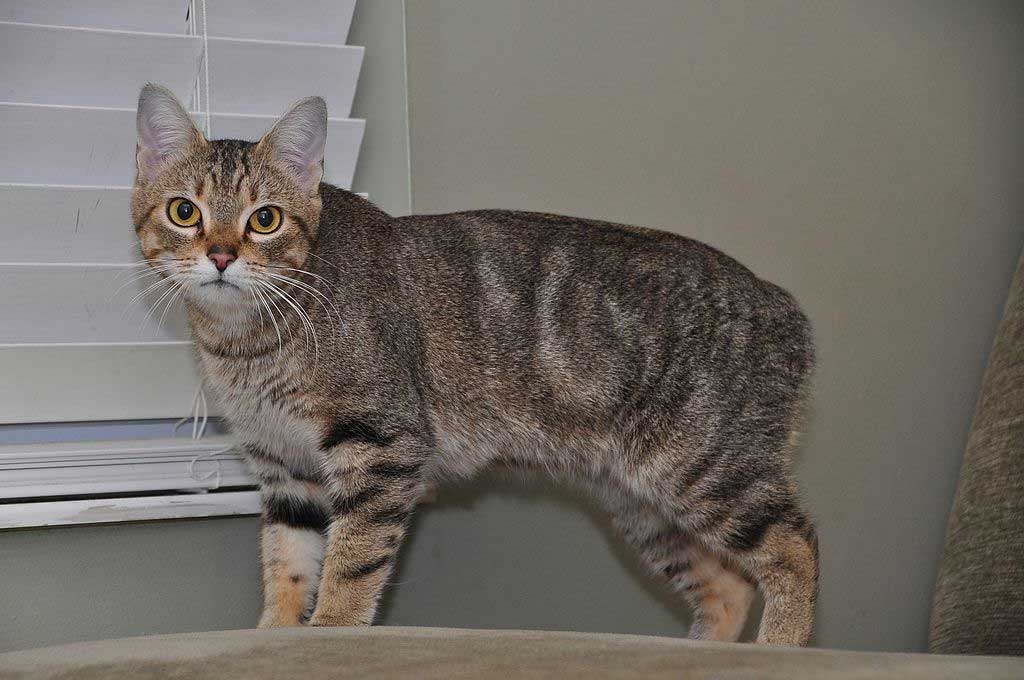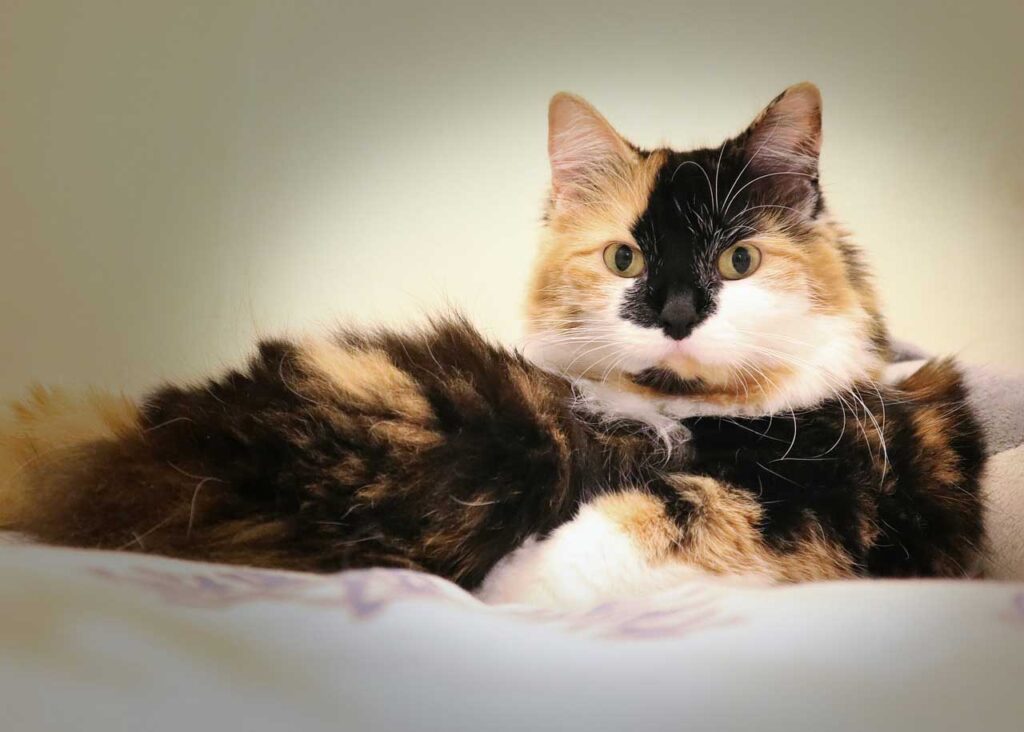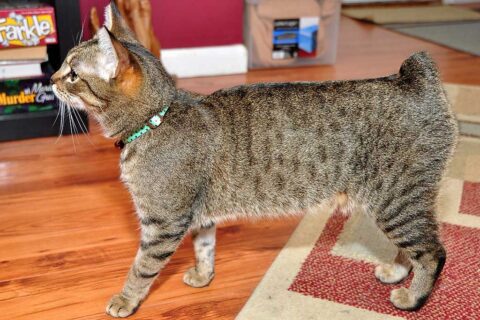Content |
|---|
Characteristics "Manx cat"
Coexistence is important that you have with your new friend. Before considering the acquisition of a cat of the breed "Manx cat" you know certain factors. You must take into account their character, their need for exercise, their interaction with other pets, their care and if you have small children, their level of tolerance towards them.
Joy4.0 out of 5 stars (based on 1 review)
|
Activity level3.0 out of 5 stars (based on 1 review)
|
Friendliness to other pets5.0 out of 5 stars (based on 1 review)
|
|---|---|---|
Friendliness to children5.0 out of 5 stars (based on 1 review)
|
Grooming requirements3.0 out of 5 stars (based on 1 review)
|
Vocality2.0 out of 5 stars (based on 1 review)
|
Need for attention3.0 out of 5 stars (based on 1 review)
|
Affection towards its owners4.0 out of 5 stars (based on 1 review)
|
Docility4.0 out of 5 stars (based on 1 review)
|
Intelligence4.0 out of 5 stars (based on 1 review)
|
Independence3.0 out of 5 stars (based on 1 review)
|
Hardiness1.0 out of 5 stars (based on 1 review)
|
History
The Manx cat It has existed since the middle of the 18th century on the Isle of Man, situated between England and Ireland, but its exact origins are the subject of speculation. A legend says that it was the last animal to climb into Noah's Ark and that its tail was cut off when the door was closed.. Another legend claims that the invaders, Vikings or Irish depending on the version, they cut off the kittens' tails to use as good luck charms: to protect their young, mother cats would have cut off their tails with their teeth at birth. Last, another wild theory is that it is the result of a cross between a cat and a rabbit, but it has been scientifically proven that it has no basis.
In fact, the most likely explanation is that it is a genetic mutation that appeared spontaneously among the island's feline population and spread rapidly thanks to its dominance (it is enough that one of the two parents is a carrier of the corresponding gene, and therefore have this characteristic, so that some of the kittens are in the same case).

The presence of cats on the Isle of Man is also the subject of speculation. One of the theories is that the Vikings took them to the 9th century, another that the English sailors took on their frequent voyages from the 13th century and another that arrived with the survivors of the sinking of a Spanish galleon in 1588. All these explanations may have some basis of truth, but one thing is true: the first representatives of the feline species that appeared on the island had a full tail.
What is also true is that the fact that the Isle of Man was a port with some international traffic in a context of increasing trade facilitated the spread of manna around the world during the 19th century., especially in the UK (since the beginning of the century) and then in the United States. This is how the Manx became one of the breeds exhibited in the first cat shows in history, which were held in Great Britain from 1871. In 1903 a breed standard was developed and the famous Cat Fanciers’ Association (CFA) recognized the breed at its founding in 1906. The same happened with the creation of the Fédération Internationale Féline (FIFé) in 1949, and then with the TICA (The International Cat Association) in 1979.
Authentic national symbol of its island of origin, where it appears mostly in coins, seals, postcards and badges, manx is still unpopular outside, despite its long history and international recognition. In United States, CFA statistics place the Manx cat between the posts 25 and 30 (of about 45) in the ranking of breeds according to the number of annual registrations. In Great Britain, there has even been a certain disaffection for this cat since 2006: while in 1997 and 2006 about forty individuals were registered per year, now their number can be counted on the fingers of one hand, although 2018 marked a jump, with 22 registered births. It remains to be seen if this holds up over time.… In France, In addition, it is a rare breed of cat, since they only registered 56 specimens in the Official Book of Feline Origins (LOOF) between 2003 and 2019. Their number is even zero in some years.
Physical characteristics
The Manx has a short morphology / Cobby. Its body it is compact and curvilinear, but well muscled and with good bones. The legs foreheads are short and widely spaced, while the rear ones are much longer.
Like the rest of the body, the head of the Manx cat she is also plump, seated on a neck wide and short. The ears are size medium, wide at the base and rounded at the tip. The eyes they are large and round and can be of various colors: yellow, copper, Hazelnut, green or even blue.
The no tail is the most distinctive feature of this cat. Unlike in the Bobtails, they have a short tail, the Manx has no tail at all (variety rumpy), or just a bone growth (variety riser) consisting of one to three sacral vertebrae, that is to say, at hip level. The standard of the Official Book of Feline Origins (LOOF) also recognizes specimens with a short tail formed by between 1 and 3 caudal vertebrae, that is to say, located beyond the hips and that, Therefore, already forms a queue (variety “stumpy“), but neither the Cat Fancier’s Association (CFA) neither him Governing Council of the Cat Fancy (GCCF) accept them. There's also Manx cats that have a tail as long as that of another breed (variety “longy“); they are not recognized as Manxs by no rule, but they remain in the breeding program, since they can still give birth to tailless individuals (“rumpy” or “riser“).
The fur consists of a dense, cottony undercoat and a harder, glossier topcoat. The undercoat may be less dense in summer, and white or light-colored specimens may have a softer top coat. Your top coat can be short or long. But, while some organizations consider that the Manx longhair it is a mere variety, other (as the Fédération Internationale Féline or The International Cat Association) consider it a breed in its own right, other than Manx and named Cymric cat.
All are accepted coat colors, except for those resulting from hybridization: chocolate or lavender. Similarly, all patterns are possible except the Himalaya.
Last, the sexual dimorphism it is well marked, the female being smaller than the male.
Size and weight
- Size: 35 cm.
- Weight: Of 3,5 to 5,5 kg

Varieties of “Manx cat”
The Manx longhair, also known as Cymric cat, is considered by feline associations well as a simple variety of the Manx (this is the position taken by the British Governing Council of the Cat Fancy and American Cat Fanciers’ Association), fine as a breed in its own right (this is the case, for example, of the Fédération Internationale Féline and The International Cat Association).
It also, not all individuals, whether they are short or long hair, completely lack a tail (variety rumpy) or have a small bump made up of one to three sacral vertebrae (variety riser). There are also short-tailed individuals (stumpys) with one to three vertebrae in the tail, and long-tailed individuals.
The latter are not considered Manx, but nevertheless they are used in the breeding program, since they can give birth to healthy litters with kittens rumpy or riser. This is lucky, since the offspring of two parents rumpy or riser it's troublesome, since some of their offspring are victims of the manx syndrome or even die before being born.
Character and skills
The Manx cat he is affectionate with his whole family, but he usually has a favorite person who he follows around the house and with whom he likes to rest. They are perfectly capable of spending the day alone when their owners are away., but they prefer the company of their humans to solitude: they are not a suitable cat breed for someone who is absent often.
Its playful nature makes it a breed of cat suitable for children, provided they have learned to behave with and respect animals. He also gets along well with other cats and with dogs accustomed to cats, as long as they get to know each other little by little. On the other hand, how he has preserved his hunting instincts, the little rodents, birds or fish would run a great risk of a quick and tragic end if they had to cohabit with a Manx.
Rather suspicious in character, is reserved with strangers and is even an excellent guardian cat -or at least alert-, who does not stop warning his master when a newcomer approaches. If you see that the owner remains calm, accept the situation and observe it.
Clever and skillful, the Manx cat It is a good option for those who want to teach their cat tricks, as for example, to retrieve an object. They are also very good when walked on a leash. On the other hand, his intelligence can also turn against his master: It is very probable, for example, who understands how a doorknob works, so it is advisable to close the food cupboard.
This is especially true because, despite his fat and lack of a tail, that might be mistakenly thought to impair your sense of balance, the Manx is surprisingly agile and active. Its powerful hind legs make it an excellent jumper, and it is quite common to find it sitting on top of a cupboard. Having said that, it is also a breed of cat that adapts well to life in a flat, as long as I have enough opportunities to run and play.
From its island origins, the Manx cat retains a fascination for water, what can take you, for example, to observe a tap that is open for a long time or to play with the water in the bath. But, this does not go much further: does not like to get wet and, therefore, does not have the possibility to follow his master in the shower.
Last, this cat has a nice voice, who does not hesitate to share with others by having a conversation from time to time.
Grooming "Manx cat"

The Manx it is an easy cat to care for: just brush it once a week to keep its coat healthy. But, this frequency should be increased during the annual spring and fall molts, when it is necessary to brush every 2 or 3 days to remove excess dead hair.
Weekly brushing of the cat's hair is an opportunity to ensure that its teeth are free of cavities and tartar., and that their eyes and ears are clean. They should be cleaned with a damp cloth.
Last, if they have become too long, you should cut your cat's nails with a nail clipper to prevent it from being hindered in its movements. But, this operation is not usually necessary, since a cat trims its nails regularly and keeps them in good condition and with the right length.
Health and nutrition
The Manx cat is a carrier of a gene responsible for the disappearance of its tail, what has consequences on your health. This gene is dominant (it is not necessary for both parents to have this anatomical feature for their kittens to have it), but it is not expressed in the same way in all cats, so some do not have a tail, while others have a partial tail.
"Manx cat" |
||
|---|---|---|
 | ||
A fetus that receives two mutated genes has serious developmental problems and usually dies in the womb.. Those with only one mutated gene manage to develop, either no tail or with a short tail; in the latter case they are called variety “stumpy“. But, between 20% and the 30% of them are affected by what is commonly called “manx syndrome”.
Affects the spine and various internal organs, like bladder, intestines or stomach. These deformities are fatal in the long run, so affected kittens are usually euthanized. Those who are not usually die after 3 or 4 years, with a peak of 5 years. The syndrome is detectable from 4-6 months old watching the kitten, so a responsible Manx breeder will not put kittens up for adoption before this age.
Individuals who are saved tend to live long, most exceed 15 years of age and some reach 20. Yes indeed, are more likely to suffer from certain diseases:
- The tail arthritis, which mainly affects purebred individuals and can be very painful for the animal;
- The corneal dystrophy, a genetic eye disease that begins around the 4 months old and causes vision problems that can lead to blindness.
Food
The Manx is not picky about food and can be fed commercially available industrial cat food without any problem. It must be ensured that the quality of the feed is sufficient to provide the necessary essential nutrients, depending on the age and activity level of the cat.
This cat is a greedy guy and has a healthy appetite. So, not necessarily capable of self-regulation, so it is best to avoid leaving food at your disposal all the time: its owner must, on the other hand, make sure to provide you with daily rations tailored to your needs, and ensure that you are not overweight. If this is the case, a veterinarian should be consulted to establish an appropriate feeding program.
For sale "Manx cat"
The price of a kitten Manx male is about 800 EUR, while that of a female Manx is of some 700 EUR.
Videos "Manx cat"
|
|
|
|---|
Alternative names:
- Manks
- Stubbin
- Rumpy
- Isle of Man cat

